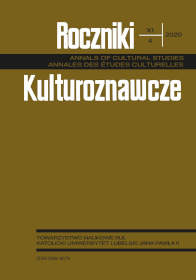What Does the Middle Ages Teach Us for Today?
Abstrakt
Czego uczy nas dzisiaj średniowiecze?
Na tyle, na ile można posłużyć się historią do zrozumienia swojego czasu, z badań nad średniowieczem można wyciągnąć trzy główne wnioski. Po pierwsze, powtarzająca się konfrontacja z nowymi ludami nie przeszkodziła w powstaniu jednej wspólnoty kulturowej. Po drugie, wśród przyczyn, które pozwoliły na tę asymilację, jest coś, co można by nazwać „kompleksem niższości”, który paradoksalnie popychał ludzi średniowiecza do ciągłego wprowadzania innowacji z podziwu dla swoich prestiżowych poprzedników. Wreszcie pragnieniu jedności towarzyszyły liczne napięcia i faktyczny pluralizm, ponieważ jednoczących biegunów było kilka: filozoficzna mądrość odziedziczona z Aten, prawo cywilne przekazane z Rzymu, wiara chrześcijańska otrzymana z Jerozolimy.
Bibliografia
Ampère, Jean-Jacques. Histoire littéraire de la France avant le xiiie siècle. Paris: Hachette, 1838.
Augustine. De Civitate Dei, edited by Bernard Dombart and Alphonsus Kalb. Corpus Christianorum, Series Latina, 47–48. Turnhout: Brepols, 1955.
Bermond, Pascale, and Isabelle Moulin (eds.). Commenter au Moyen Âge. Paris: Vrin, 2020.
Blanchard, Joël. La fin du Moyen Âge. Paris: Perrin, 2020.
Dahan, Gilbert. Les intellectuels chrétiens et les juifs au Moyen Âge. Patrimonies, judaïsme. Paris: Cerf, 1990.
Dahan, Gilbert. L’exégèse chrétienne de la Bible en Occident médiéval, XIIe-XIVe siècle. Patrimoines, Christianisme. Paris: Cerf, 1999.
Emery, Gilles, and Matthew Levering (eds). The Oxford Handbook of the Trinity. Oxford: Oxford University Press, 2011.
Fontaine, Jacques, and Christine Pellistrandi. L’Europe héritière de l’Europe wisigothique. Madrid: Casa de Velazquez, 1992.
Ghellinck, Joseph. “Nani et gigantes.” Archivum Latinitatis Medii Aevi 18 (1943–1944): 25–29.
Goffart, Walter A. Barbarians and Romans AD 418-584. The Techniques of Accommodation, Princeton: Princeton University Press, 1980.
Heather, Peter J. The Fall of the Roman Empire. A New History. London: Macmillan, 2005.
Hamesse, Jacqueline, and Olga Weijers. Écriture et réécriture des textes philosophiques médiévaux. Volume d’hommage offert à Colette Sirat. Textes et études du Moyen Age. Turnhout: Brepols, 2006
Harris, Jonathan. The End of Byzantium. Yale: Yale University Press, 2010.
Haskins, Charles Homer. The Renaissance of the Twelfth Century. Cambridge: Cambridge University Press, 1927.
Hugh of Saint-Victor. Didascalicon, edited by Charles Henry Buttimer: Hugonis de Sancto Victore. Didascalicon. De Studio Legendi. Washington: Catholic University Press, 1939; English translation of Jerome Taylor: The Didascalicon of Hugh of St Victor. New York: Columbia University Press, 1961; and the recent translation of Franklin T. Harkins in: Franklin T. Harkins and Frans van Liere (eds). Interpretation of scripture: theory. A selection of works of Hugh, Andrew, Richard and Godfrey of St Victor, and of Robert of Melun. Turnhout: Brepols, 2012.
Huyzinga, Johan. Herfsttij der Middeleeuwen. Leiden: Leiden University Press, 2018 (1st ed. 1919). Translated as The Waning of the Middle Ages. London: Penguin Books, 1924.
Jeauneau, Éduard de. “Lectio philosophorum”. Recherches sur l’École de Chartres, 51–74. Amsterdam: Adolf M. Hakkert, 1973.
Jeauneau, Éduard de. “Nani gigantum humeris insidentes. Essai d’interprétation de Bernard de Chartres.” Vivarium 5 (1967): 79-99. DOI: https://doi.org/10.1163/156853467X00078.
John of Salisbury. Metalogicon, edidit John Bernie Hall, auxiliante K.S.B. Keats-Rohan: Iohannis Saresberiensis Metalogicon. Corpus Christianorum Continuatio Mediaevalis, 98. Turnhout: Brepols, 1991.
Nathan, Geoffrey. “The Last Emperor: The Fate of Romulus Augustulus.” Classica et Mediaevalia 43 (1992): 261–271.
Naumann, Hans. Karolingische und ottonische Renaissance. Frankfurt am Main: Englert und Schlosse, 1927.
Neuman de Vegvar, Carl L. The Northumbrian Renaissance: a study in the transmission of style. Cranbury: Associated University Press, 1987.
Patzelt, Ema. Die Karolingische Renaissance. Beiträge zur Geschichte der Kultur des frühen Mittalters. Wien: Österreichischer Schulbücherverlag, 1924.
Pierre de Blois. Epistula 92. PL 207, 290AB.
Rashdall, Hastings, Frederick Maurice Powicke, and Alfred Brotherstan Emden. The Universities of Europe in the Middle Ages, 3 vol. Oxford: Clarendon Press, 1987.
Riché, Pierre. Éducation et culture dans l’Occident barbare, VIe-VIIIe siècle. Patristica Sorbonensia, 4. Paris: Seuil, 1962.
Verger, Jacques. La Renaissance du XIIe siècle. Initiations au Moyen Âge. Paris: Cerf, 1999.
Weijers, Olga. In Search of the Truth: A History of Disputation Techniques from Antiquity to Early Modern Times. Studies on the Faculty of Arts, History and Influence, 1. Turnhout: Brepols, 2013.
Wright, Thomas (ed.). Alexandri Neckham De naturis rerum libri duo. Rolls Series, 34. London: Longman and Green, 1863.
Zimmermann, Michel (ed.), Auctor et auctoritas. Invention et conformisme dans l’écriture médiévale. Actes du colloque tenu à l’Université deVersailles — Saint-Quentin-en-Yvelines (14–16 juin 1999). Mémoires et documents de l’École des chartes, 59. Paris: École nationale des chartes, 2001.





